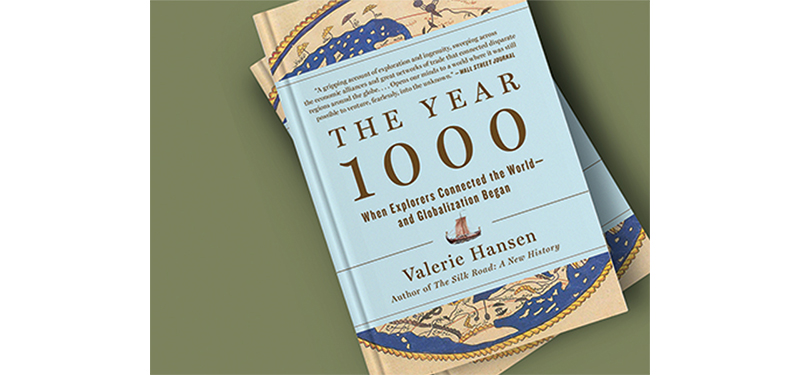Book Review: The Year 1000
The Year 1000 When Explorers Connected the World and Globalization Began

With China and the United States locking horns over trade, an increasing tendency towards nativism around the world and a recognition that globalisation is not always a good thing, the publication of Valerie Hansen’s The Year 1000 is a timely one.
In this vivid and edifying account, the Yale history professor traces the roots of globalisation to the end of the first millennium. She contends that it was the trade networks and channels established during this period that set the stage for Europe’s golden age of exploration five centuries later.
Given that a thousand years ago, as it is now, China was a major global power, a third of the book covers the Middle Kingdom’s relationships with Central Asia, the Indian subcontinent as well as Southeast Asia.
Long before Columbus, the trade routes that connected the southern ports in China to the Persian Gulf served as the world’s busiest superhighways for many centuries. The routes lost their importance over time when traders in the Middle East switched to exporting cheaper and better aromatic products from Southeast Asia instead. This shift in sourcing patterns had a tremendous impact on the indigenous societies in this region as they transformed from hunter-gatherers to agriculturalists.
This book is not just about China of course. Hansen has written a riveting story highlighting the changes taking place in other parts of the world during the same period: from Viking voyages to North America to the movement of goods and information between the Mayan city of Chichén Itzá and Chaco Canyon in present-day New Mexico. Hansen never allows her account to be bogged down by too much detail. Her scholarship and research shine through in vignettes and accounts that delight as well as inform.
In one chapter, she recounts how the Rus, a band of fur and slave traders of Swedish origin, helped to found the domains that still commemorate their name (Russia). Another nugget of information is the etymology of the word “slave” which is derived from the Slavs, a people who inhabited a large part of Eastern Europe and who were trafficked as the original human cargo, predating the African slave trade.
Particularly fascinating is the account of how representatives from the major religions at the time – Judaism, Islam, Latin-rite Christianity (centred in Rome) and Eastern-rite Christianity (based in Constantinople) – attempted to convert the Rus leader, Prince Vladimir, a follower of Slavic paganism (he eventually converted to Eastern-rite Christianity in 988). Hansen cites this as an example of the enormous impact religion had on global affairs during that period. It is her ability to toggle between the big picture and small details – while retaining a breezy writing style – that makes this book such a pleasure to read.
What lessons can we draw from Hansen’s account? The words of philosopher and novelist George Santayana – “Those who cannot remember the past are condemned to repeat it” – come to mind. Hansen acknowledges that as early as the year 1000, globalisation resulted in winners and losers, citing the Guangzhou Massacre (878–79),1 the massacre in Cairo (996)2 and the Massacre of the Latins (1182).3 In each instance, the root causes were similar: “The locals resented the wealth of the foreign expats and believed that the outsiders had profited at their expense.”
Hansen says the solution lies in how we respond to these shifts in society. History has shown that increased contact with the external world will bring about new opportunities; what is needed is to be prepared for the unfamiliar, to learn from the Other and to treat the challenges as incentives to improve. Hansen’s caution that “(t)hose who remained open to the unfamiliar did much better than those who rejected anything new” is sound advice that should be heeded as we navigate the challenges of an increasingly uncertain world.
Reviewed by Wan Wee Pin.
 Wan Wee Pin is Programme Director, National Reading Movement, National Library Board. Valerie Hansen’s The Year 1000 is available for reference at the Lee Kong Chian Reference Library, and for loan at selected public libraries
(Call nos.: R909.1 HAN; 909.1 HAN) and on NLB OverDrive.
Wan Wee Pin is Programme Director, National Reading Movement, National Library Board. Valerie Hansen’s The Year 1000 is available for reference at the Lee Kong Chian Reference Library, and for loan at selected public libraries
(Call nos.: R909.1 HAN; 909.1 HAN) and on NLB OverDrive.
NOTES
-
The Guangzhou Massacre saw the slaying of the inhabitants of Guangzhou in 878–79 by the rebel army of Huang Chao, who attempted to overthrow the Tang dynasty. Most of the victims were wealthy foreign merchants, mainly Arabs and Persians. ↩
-
In 996, merchants from Amalfi, a region in what is now Italy, were accused of starting a fire that destroyed an arsenal in Cairo. In retaliation, the people from Amalfi were killed and their churches ransacked. ↩
-
The Massacre of the Latins refers to the killing of the Roman Catholic (called “Latin”) inhabitants of Constantinople, the first city of the Byzantine Empire. The Byzantines resented the Latins, who were mainly from regions of what is now Italy. In 1182, a mob embarked on a brutal killing spree. ↩

